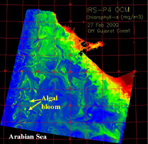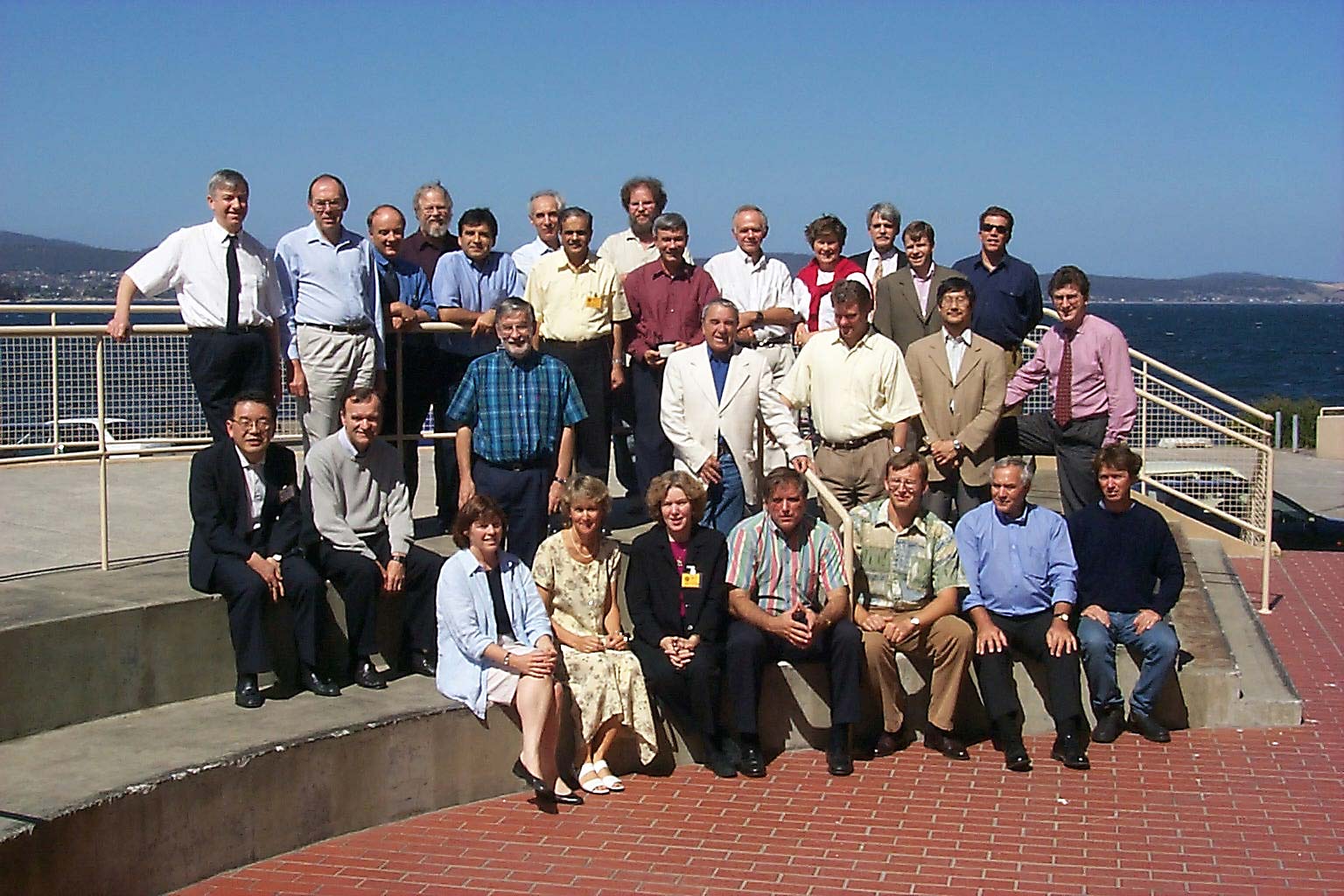

|
MODIS Update The Terra website has been updated with the latest information and images from all of the onboard sensors.
The MODIS site now has information on
MODIS Direct Broadcast, which is now available from the NASA/GSFC
Ground Receiving Station.
MODIS images can also be seen at
the Earth Observatory site. At a press conference on
April 19, instrument leaders for MODIS, MISR, MOPITT, ASTER and CERES all spoke on the status of their respective instruments, and showed off
some of the latest images received. The MODIS pages on the Terra site now have a wealth of new images, including some chlorophyll images.
MODIS image provided by NASA/Goddard Space Flight Center.
The Terra website has been updated with the latest information and images from all of the onboard sensors.
The MODIS site now has information on
MODIS Direct Broadcast, which is now available from the NASA/GSFC
Ground Receiving Station.
MODIS images can also be seen at
the Earth Observatory site. At a press conference on
April 19, instrument leaders for MODIS, MISR, MOPITT, ASTER and CERES all spoke on the status of their respective instruments, and showed off
some of the latest images received. The MODIS pages on the Terra site now have a wealth of new images, including some chlorophyll images.
MODIS image provided by NASA/Goddard Space Flight Center.
SeaWiFS in the news again  SeaWiFS is in the news again, this time with a little help from it's friends. The Blue Marble 2000 image, a composite of
data from SeaWiFS, GOES (Geostationary Operational Environmental Satellite and POES (Polar Orbiting Environmental Satellite,
is intended as an update to the original Blue Marble image of Earth as seen from the Apollo missions to space.
The image was created to mark the 30th Anniversary of Earth Day on April 22nd. Hurricane Linda can be seen on the image in the Pacific, as can the moon,
which has been added for effect. The orientation of the earth on this image concentrates on the Americas, as opposed to the
Apollo Blue Marble, which viewed the Earth looking down on Africa.
SeaWiFS is in the news again, this time with a little help from it's friends. The Blue Marble 2000 image, a composite of
data from SeaWiFS, GOES (Geostationary Operational Environmental Satellite and POES (Polar Orbiting Environmental Satellite,
is intended as an update to the original Blue Marble image of Earth as seen from the Apollo missions to space.
The image was created to mark the 30th Anniversary of Earth Day on April 22nd. Hurricane Linda can be seen on the image in the Pacific, as can the moon,
which has been added for effect. The orientation of the earth on this image concentrates on the Americas, as opposed to the
Apollo Blue Marble, which viewed the Earth looking down on Africa.There is a website available for the Blue Marble project, with many images and information on how the Blue Marble 2000 was created. Check our own gallery pages for more images from SeaWiFS. The Goddard DAAC has updated its Ocean Color Data and resources page, which includes some new sections added to the Science Focus! pages. Image provided by NASA/GSFC/NOAA/USGS.
Ocean-Color Imager (OCI)  Taiwan's Ocean-Color imager, on board ROCSAT-1, is already sending back images, some of which
can be seen on the new ocean-colour gallery pages.
Taiwan's Ocean-Color imager, on board ROCSAT-1, is already sending back images, some of which
can be seen on the new ocean-colour gallery pages.
MODIS-FM1  A new website has been posted on the internet with details of the second MODIS ocean-colour instrument, due for launch
on December 21st, 2000. NASA's MODIS-FM1 will be on board
Aqua, previously known as EOS-PM1.
A new website has been posted on the internet with details of the second MODIS ocean-colour instrument, due for launch
on December 21st, 2000. NASA's MODIS-FM1 will be on board
Aqua, previously known as EOS-PM1.The excellent new site, which is located at http://eos-pm.gsfc.nasa.gov/, includes information on the mission, the spacecraft and instruments, including MODIS-FM1, and also includes a photo gallery.
ADEOS-2  The NASDA websites are now operational again. A new page dedicated to
ADEOS has been created. This is in addition to
the link already on the IOCCG sensors page.
ADEOS, which will be on board the H-IIA
rocket, is now anticipated to be launched some time in the year 2001.
The NASDA websites are now operational again. A new page dedicated to
ADEOS has been created. This is in addition to
the link already on the IOCCG sensors page.
ADEOS, which will be on board the H-IIA
rocket, is now anticipated to be launched some time in the year 2001.
OCM Gallery  The Ocean Colour Monitor, on board India's IRS-P4 satellite, is sending back some good images, some processed ocean-colour images from OCM are available on our gallery pages.
The Ocean Colour Monitor, on board India's IRS-P4 satellite, is sending back some good images, some processed ocean-colour images from OCM are available on our gallery pages.
More phytoplankton off Chile? A New Scientist report states that the Chilean government is looking into the possibility of fertilising the sea with nitrogen to increase biological activity, and thus reduce carbon dioxide levels, through phytoplankton growth. The proposal is based on plans from Ian Jones, of the University of Sydney's Ocean Technology Group, and Toyo Engineering in Japan. The levels of CO2, it is reported, could be reduced by such a method, and satellite ocean-colour sensors would be able to monitor progress. The proposal is, however, a controversial one, as opponents of such a procedure argue that the existing balance in the ecosystem will be altered by the addition of more nitrogen into the ecosystem. This report follows on from a previous article in New Scientist (October 2nd, 1999), which looked at a company, Ocean Farming, and their highly controversial plans for fertilising the sea around the Marshall Islands to increase phytoplankton levels, the end result of which would be to harvest more fish.
Where is Terra? Although SeaWiFS has on it's website an updated locator for exactly where the sensor is at any given time, a new locator of satellites is now available. If you want to find out when an earth-observing satellite will pass over your location, it is now possible, by visiting NASA's Earth Observatory's Satellite Overpass Predictor Page. With the ability to select over 800 cities, as well as enter any lat./long., a table showing the date, time, and elevation when it may be possible to see any given satellite (from a drop-down menu) passing overhead is generated. A good way to impress friends and family as you can look into the starry sky and say, "Look, there's Terra passing overhead..."
Software updates The IOCCG software page is going to be changed in the near future. In the meantime, two links to software have been added, one for the calculation of SSI and PAR from SeaWiFS data; the other an image analysis and visualization package (WIM). |
SeaWiFS Data Reprocessing The SeaWiFS Project is currently installing new production software, with the first reprocessed (Version 3) files expected to arrive at the Goddard DAAC around May 11th, 2000. As the reprocessed data is received from the SeaWiFS Project, Version 3 files will reappear, starting at the beginning of the mission. At the same time, new data received while the reprocessing is taking place will also become available at the DAAC. Some data products are being deleted, and others are being added; the contents of the data files are being changed (including more useful information).
Gallery Updates Some new images from SeaWiFS, MOS and OCM have been added to the IOCCG ocean-colour image gallery. Some MODIS images have also been added to the pages. Images can be viewed by continent or by sensor. Any images you would like to see in this section can be submitted to us electronically by e-mail.
Workshops, Conferences and Training Courses There will be a special session at UK Marine Sciences 2000 (10 - 15 September at the University of East Anglia) which is part of the main conference but will also serve as an ocean colour meeting. The deadline for abstracts [400 words or less online] is 19th April 2000.
The second announcement has been made for the 2000 Summer Course of the
International Advanced School "Leonardo da Vinci." The focus of the course is on
"Processes in the Coastal Zone: Links to Management Issues". The Sixteenth Session of the IOC Committee for International Oceanographic Data and Information Exchange (IODE-XVI) will be held between October 30th and November 9th 2000 in Portugal. A website with documentation and information will be avilable from May 15th. The IGARSS 2000 conference is to be held from the 24th to the 28th of July 2000, at the Hilton Hawaiian Village, Honolulu, Hawaii. The title of the conference is "Taking the Pulse of the Planet," and is subtitled: The Role of Remote Sensing in Managing the Global Environment. "The largest Oceanographic Meeting ever" is the title on the webpage announcing 2001: An Ocean Odyssey, a conference to be held in Mar del Plata, Argentina from October 21-28, 2001. Their website with all of the relevant information is currently running, however the main announcement and call for papers have not yet been issued.
Fifth Workshop on "Physical Processes in Natural Waters", August 23-29, 2000, Irkutsk, Russia.
A training course in México has been announced, at the
Departamento de Oceanografía Física, CICESE, Ensenada B. C. For a more detailed list of workshops refer to our workshop page, and for training courses, our training page.
5th IOCCG Meeting Minutes  The fifth IOCCG Committee meeting took place from February 1st - 4th in Hobart, Tasmania. The minutes from the meeting are now available on the Workshops & Conference Page.
References In another new section of the IOCCG website, we will be placing recent, relevant publications in the various aspects of ocean colour. The new page will be frequently updated, and every several months, we will incorporate these new references into our existing, extensive bibliography, which has also been updated. This page has been updated again (as of April 4th) with another twenty references. To go to the new references page, click here.
Employment updates Three further positions have been posted on the employment page: a postdoctoral position at the University of California, a position at the Goddard Space Flight Center (GSFC), and Assistant Professor of Biological Oceanography at Old Dominion University in Virginia, USA. |
|
Material for possible inclusion in the IOCCG Newsletter should be submitted to the Project Scientist. If you would like to be placed on the IOCCG News mailing list, and receive a brief summary of the latest news by e-mail (approximately once every 2 months), please send an e-mail with 'subscribe' in the subject line to subscribe@ioccg.org.To unsubscribe from the IOCCG News mailing list please send a message with 'unsubscribe' in the subject line to unsubscribe@ioccg.org.
|
|
|
|